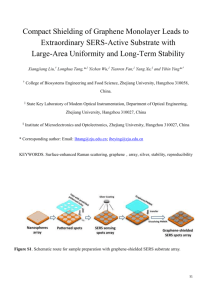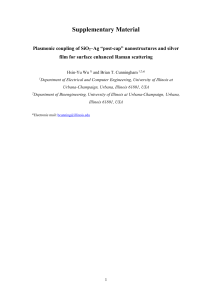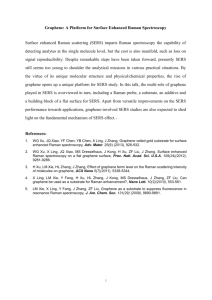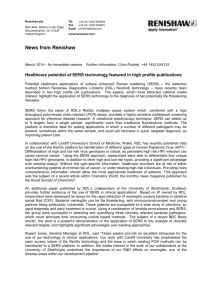SERS Surface Enhanced Raman Spectroscopy
advertisement
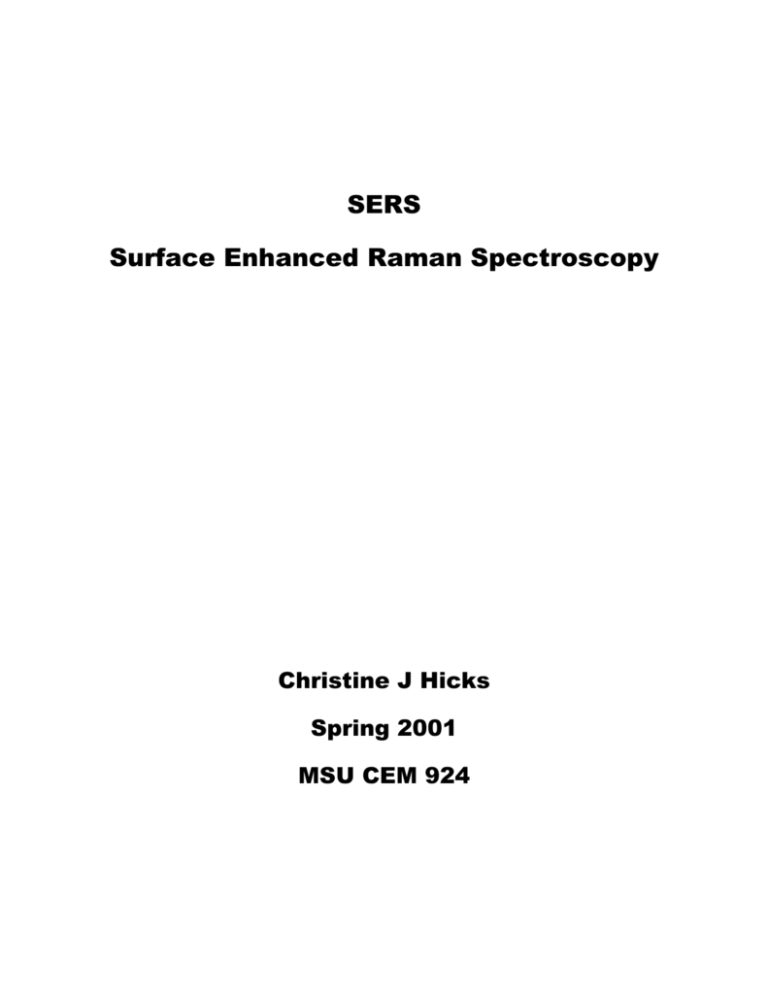
SERS Surface Enhanced Raman Spectroscopy Christine J Hicks Spring 2001 MSU CEM 924 1 Introduction to SERS Surface Enhanced Raman Spectroscopy (SERS) is a Raman Spectroscopic (RS) technique that provides greatly enhanced Raman signal from Raman-active analyte molecules that have been adsorbed onto certain speciallyprepared metal surfaces. Increases in the intensity of Raman signal have been regularly observed on the order of 104-106, and can be as high as 10 8 and 1014 for some systems.8,10 The importance of SERS is that it is both surface selective and highly sensitive where as RS is neither. RS is ineffective for surface studies because the photons of the incident laser light simply propagate through the bulk and the signal from the bulk overwhelms any Raman signal from the analytes at the surface. SERS selectivity of surface signal results from the presence of surface enhancement (SE) mechanisms only at the surface. Thus, the surface signal overwhelms the bulk signal, making bulk subtraction unnecessary. There are two primary mechanisms of enhancement described in the literature: an electromagnetic and a chemical enhancement. The electromagnetic effect is dominant, the chemical effect contributing enhancement only on the order of an order or two of magnitude.7 The electromagnetic enhancement (EME) is dependent on the presence of the metal surface’s roughness features, while the chemical enhancement (CE) involves changes to the adsorbate electronic states due to chemisorption of the analyte.14 The structural and molecular identification power of RS can be used for numerous interfacial systems, including electrochemical, modeled and actual biological systems, catalytic, in-situ and ambient analyses and other adsorbate-surface interactions.5,8,14,15 Due to the sensitivity of SERS, detection of trace molecules can be accomplished, as well.8 SERS is observed primarily for analytes adsorbed onto coinage (Au, Ag, Cu) or alkali (Li, Na, K) metal surfaces, with the excitation wavelength near or in the visible region.5 Theoretically, any metal would be capable of exhibiting SE, but the coinage and alkali metals satisfy calculable requirements and provide the strongest enhancement.10 Metals such as Pd or Pt exhibit enhancements of about 102-103 for excitation in the near ultraviolet.10 The importance of SERS is that the surface selectivity and sensitivity extends RS utility to a wide variety of interfacial systems previously inaccessible to RS because RS was not surface sensitive. These include in-situ and ambient analysis of electrochemical, catalytic, biological, and organic systems.2,8,14,145 Zou, et al discuss the alternative surface techniques (Sum Frequency Generation, Infrared Reflection Absorption Spectroscopy, and Electron Energy Loss Spectroscopy) whose limitations include a need for ultra high vacuum (UHV) conditions, low wavenumber range, low sensitivity, and bulk phase interference. SERS can be conducted under ambient conditions, has a broader wavenumber range, is quite sensitive and is surface selective. 2 Figure 1 shows silver roughness features on a silver surface. The metal surface can be roughened using one of several methods. The roughness features are on the order of tens of nanometers; small, compared to the wavelength of the incident excitation radiation.10, 13 The small size of the particles allows the excitation of the metal particle’s surface plasmon to be localized on the particle. The resultant electromagnetic energy density on the particle is the source of the EME mechanism and the primary contributor to the enhancement observed in SERS. The EME Mechanism and Surface Roughness Features The greater part of the overall enhancement of SERS is due to an electromagnetic enhancement mechanism that is a direct consequence of the presence of metal roughness features at the metal surface. These features can be developed in a number of ways; for example: oxidation-reduction cycles on electrode surfaces; vapor deposition of metal particles onto substrate; metal spheroid assemblies produced via lithography; metal colloids; and, metal deposition over a deposition mask of polystyrene nanospheres.6,10 All of these methods leave the metal surface with small metal particles or aggregates of particles that are capable of serving as metal roughness features. The intensity of the Raman scattered radiation is proportional to the square of the magnitude of any electromagnetic (em) fields incident on the analyte. ΙR α E2 where ΙR is the intensity of the Raman field, and E is the total em fields coupling with the analyte; and where E = Ea + Ep for which Ea is the em field on the analyte in the absence of any roughness features and Ep is the em field emitted from the particulate metal roughness feature.5,10 Of course, the em field of the excitation radiation is incident on the analyte. This is the case for normal Raman scattering and the Ea is relatively small since the source of the em radiation is relatively far away (the laser). This is one of the reasons why RS is a spectroscopy with notoriously weak signal. However, in SERS, the presence of the roughness feature provides another em field, that of the metal particle itself, Ep, and this em field is quite proximate as the analyte is adsorbed onto the roughness feature, of which the surface is composed. Because of this proximity, any em field from the particle will contribute a large factor to E. The magnitude of the em field of the particle is, thus, crucial to the intensity of Raman signal. Since the surface electrons of the metal are confined to the particle whose size is small, the plasmon’s excitation is also confined to the roughness feature. The resulting em field of the plasmon is very intense.10 The large em energy density on the particle effects the ΙR of the scatterer as shown in the above relationships. 3 It follows, too, that the analyte adsorbed between two SERS-active particles will be further enhanced than the analyte proximate to only one such particle.8 Optimization Since the roughness features are so important to SERS, much attention has been given to their study. Normal roughening procedures produce heterogeneous surfaces where the particles have a variety of sizes, shapes, and orientations.4 The frequency of incident light that is effective in producing the intense em field on the particle is dependent on these characteristics of the roughness features as well as on the type of metal used. The orientation and shape characteristics of the particle certainly effect the optimal excitation frequency, as is evident within certain elaborate calculations that won’t be presented here.10 Simply put, the EME is strongest where the particle has the highest curvature; thus the adsorption of the analyte on the long or narrow axis of an ellipsoid or spheroid effects the magnitude of the SERS enhancement. 6,10 Emory, et al. recently examined the optical enhancement of differently sized silver particles on the SERS spectra of Rhodamine 6G. They used Atomic Force Microscopy (AFM) to determine the size of the particles primarily responsible for the analyte’s signal enhancement; these particles are often called ‘hot particles’. Silver particles responsive to three excitation wavelengths (488 nm, 568 nm, and 647nm) were scanned and found to have an average diameter of 70±6nm, 140±9nm, and 190-200±20nm, respectively.4 This work confirms that the size of the particle effects the optimal excitation frequency and it can be inferred that the presence of a heterogeneously roughened surface reduces the efficiency of the SE since there would be only a fraction of available particles whose enhancement abilities were optimized at any given excitation energy.4,8Jensen, et al. found that the optimal excitation wavelength changes for particles of varying heights (Figure 2), even when the diameter of the particle was kept constant. The value of D for Figure 2 is the diameter of the (A) polystyrene Figure 2: UV-vis extinction spectra for Ag nanoparticles arrays on glass. All spectra have a constant in-plane width produced from a nanosphere deposition mask with D = 310 nm (a = 90 ± 6 nm). Out-of-plane height, b, was varied. (A) b = 58 nm; _max = 501 nm. (B) b = 53 nm; _max = 517 nm. (C) b = 43 nm; _max = 533 nm. (D) b = 38 nm; _max = 544 nm. (E) b = 33 nm; _max = 563 nm. (F) b = 23 nm; _max = 585 nm. From Jensen, et al. J. Phys. Chem. B 2000, 104, 10549 –10556. 4 (B) nanosphere used to create the deposition mask (vida infra); the value of a is the in-plane diameter of the deposited silver particles; the value of b, the out-of-plane diameter was changed and the absorption spectrum taken to determine the optimal excitation _. While the observations of Emory’s and Jensen’s groups are interesting in themselves, most significant is the development by Jensen and Van Duyne, et al of a controllable, predictable, and thus, reproducible, metal particle deposition scheme which allows tunability of the roughness features to a desired excitation wavelength.6 Irreproducibility of SERS-active substrates is a major limitation to the general analytical applicability of SERS and this work suggests an end to that limitation.8 Jensen, et al used surfaces of mica or glass onto which was deposited a monolayer of polystyrene nanospheres. The nanospheres are of a single uniform size and self-associate into two-dimensional hexagonal array (see Fig 3). Silver is then deposited over the nanospheres, resulting in SERS-active metal particles of uniform geometry and morphology.6 As with any analytical technique, attempts to optimize the system were made. With SERS, the incident light energy can be chosen such that it optimizes excitation of both the analyte and the particle plasmon, resulting in improved coupling between their em fields. It is evident in the literature that any Resonance Raman Spectroscopy (RRS) enhancement is in addition to the enhancements of SERS since molecules that exhibit SERS can be further enhanced by use of a laser frequency providing RRS enhancements.12 Surface Enhanced Resonance Raman Spectroscopy (SERRS) can be accomplished by choosing the excitation wavelength such that it interacts with the stable excited electronic state of the analyte molecule and combining the RRS effect with a SERS active substrate.2,8 Other Enhancement Effects While the EME is the primary contributor to the SERS enhancement, other mechanisms cannot be neglected for a thorough understanding of SERS. Another electromagnetic effect arises from flat, as well as from roughened surfaces. The em field of the incident radiation couples with the analyte. In addition, that same field is reflected by the surface of the metal and the reflection couples with the analyte, resulting in a four-fold enhancement of the single analyte’s scattered signal. Another four-fold enhancement occurs when the scattered field is reflected by the surface, for a total theoretical reflectant enhancement of sixteen-fold. This translates into an experimentally observed four- to six-fold enhancement that can be attributed to 5 this mechanism.5,10 The chemical enhancement (CE) mechanism provides an order or two of magnitude enhancement to the Raman signal intensity.7 It is less understood than the EME enhancement, but brings some interesting considerations to a thorough discussion of SERS. The molecule adsorbed onto the surface necessarily interacts with the surface. CE exists because of this interaction, which has been described in several ways. The metaladsorbate proximity may allow pathways of electronic coupling from which novel charge-transfer intermediates emerge that have higher Raman scattering cross-sections than does the analyte when not adsorbed onto the surface.8 This is very much like a Resonance Raman effect. Another explanation is that the molecular orbitals of the adsorbate broaden into the conducting electrons of the metal, altering the analyte’s chemistry2. It is interesting to note that the CE effect may be an alteration in the scattering cross-section; the chemical nature of the analyte changing due to its interaction with the metal, whereas the EME effect was a change in the intensity of those analyte molecules that did scatter, not a change in scattering cross-section. EM enhancements are apparently, and should be, chemically non-selective; that is, providing the same enhancement for different analyte molecules adsorbed onto the same type of metal surface. However, N2 and CO enhancements differ by a factor of 200. This is evidence for mechanisms other than the EME, and the CE is implicated since the polarizabilities of the two molecules are almost the same, and orientation differences of adsorption couldn’t account for a surface enhancement difference of such magnitude.2 Study of the CE is difficult because most studied surfaces are roughened and the EME and CE effects can’t be separated. However, Campion, et al studied pyromellitic dianhydride (PMDA) adsorbed onto an atomically flat Cu(111) surface. The surface’s electromagnetic contributions are small and well understood, making it easier to analyze the CE mechanism. An enhancement of 30x was detected, and described as a Resonance Raman type phenomenon. Mechanisms other than the CE were carefully ruled out.1 Ultrasensitivity Only 1 in 1011 analyte molecules inelastically scatter in Raman Spectroscopy.12 As was pointed out above, the intensity of Raman signal from a scattering molecule is greatly enhanced under SERS conditions. This suggests that low concentrations of Raman-active analyte could be detected using SERS substrates. Analyte signal has been acquired via SERS for concentrations as low as pico- and femto-molar.5,8 A typical technique for impurity detection is fluorescence spectroscopy (FS). But since FS doesn’t provide structural information, it would be helpful to scientists to not only be able to detect, but to identify the molecule and perhaps monitor structural changes. FS has cross-section as good as 10-16 cm2 / molecule. RS scattering crosssections are as poor as 10-30 – 10-25 cm2 / molecule with the higher values for quite favorable RRS systems. 6 Effective SERS cross-sections, however, can be as good as ~10-18 cm2 / molecule for Rhodamine 6G and similar dyes. The theoretical estimates for the needed cross-section for single molecule detection using SERS is 4 x 10 –18 cm2 / molecule. It is interesting to note analyte aggregation inhibits the effectiveness of SERS. That is, the most effective and reproducible SERS spectra occur for analytes of concentrations about equal to the concentration of metal particle sites.8 SERS has the potential to combine the structural information provided by RS with the sensitivity typically seen in fluorescence spectroscopy. Overlayer Techniques The distance dependence of SERS is utilized in the overlayer technique, wherein an ultrathin film of solid or liquid is adsorbed onto the SERS-active substrate and the analyte within the film can borrow the EME of the substrate and have its Raman spectra greatly enhanced. This makes SERS applicable to organic films, semiconductors, insulators, etc.14 Spacer layers can be adsorbed onto the substrate, and can alter the chemistry of either the substrate or overlayer, increasing the utility of SERS still further. An advantage to the overlayer technique is that it diminishes the inhibiting effect of metal surface defects, such as pinholes in silver.14,15 Since the primary enhancement in SERS is due to an electromagnetic effect and any em field decreases in strength with distance from the point source, it follows that an analyte could benefit from the enhancement of a SERS-active substrate even if that analyte were some distance away from the enhancing surface. Theoretical calculations have been conducted, and the SERS enhancement, G, has been found to scale with distance according to G = [ r / ( r + d ) ]12 where r is the radius of the spherical metal roughness feature and d is the distance of the analyte to that feature. Experimentally, the enhancement decreases ten-fold with a distance of 2-3 nm; a distance of 20-30 Å, or a monolayer or two.2,8,14 The transition metals do not typically give good SERS spectra, but Pd, Pt, Rh, and Ir, are useful in catalytic systems, so it would be helpful to optimize these metals for SERS. Zou, et al. make use of the distance dependence of SERS by laying transition metals over a SERS active substrate, so that studies at the transition metal surface can be conducted with the analytes or transition metal benefiting from the enhancement of the underlying SERS substrate. This approach also minimizes the ‘pinhole’ problem common in gold; that is, surface defects can greatly alter SERS efficiency and analyte adsorption thermodynamics. Deposition of a few ultrathin layers of metal onto the gold removes the effects of the pinhole sites. 7 Temperature Dependence and Time Resolution Applications In considering SERS as an analytical technique for studying catalytic systems, the effects of temperature on SERS is of interest. Pang, et al. discuss the reversible temperature dependence observed for 1-propanethiol on silver films. Their control experiments ruled out incidences of thermal desorption, contaminant evaporation, and thermal Raman shifts, leaving only an electromagnetic mechanism for SERS. Thermal desportionof the adsorbate at high temperatures was an inadequate explanation for the temperature dependence because of the experimental conditions. Contaminant evaporation was an inadequate explanation because the temperature dependence was smooth, rather than abrupt (the way it would appear if contaminants were to suddenly evaporate from the surface). Thermal population of vibrational states was discounted as well, leaving only the EM model to explain the temperature dependence. They then present equations to demonstrate that the temperature dependence weakens as the aspect ratio of the SERS-active particle deviates from the optimum values.10 Chiang, et al. elaborated on the work of Pang, et al, pointing out that there is a temperature dependence for the vibration of the surface plasmon, which of course affects the incident radiation frequency dependence of the SERS substrate change.3 This means that optimization of the incident laser radiation would need to include a consideration of temperature, as well as analyte, metal, and roughness feature characteristics. As an example of the utility of SERS for studying biological systems, consider the work of Lecomte et al. The structural dynamics of the biological electron transport heme proteins have been studied. The SERS spectra were resolved to the picosecond time scale, and provided information regarding the structural changes of the species involved in the charge transfer process. Summary The limitations of normal RS effect SERS, as well, in that the analyte must still be Raman active. SERS has its own unique limitations. Many of these are due to the difficulty of obtaining reproducible SERS-active substrates. With the work of Jensen and Van Duyne, however, this limitation is likely to become less restricting. There may always be, however, the problem of the thermodynamics of analyte adsorption to the surface of interest. It may be difficult to obtain calibration curves for single analytes, and moreso for complex mixtures.8 Also, the SERS spectra may not be as compound-unique as scientists might like. Nevertheless, complex mixtures and trace analysis can be accomplished. 8 LITERATURE 1. Campion, A; Ivanecky III, J.E; Child, C.M. and Foster, M. J. Am. Chem. Soc. 1995, 177, 1180711808 2. Campion, A. and Kambhampati, P. Chem. Soc. Rev. 1998, 27, 241-250 3. Chiang, H.-P.; Leung, P.T.; and Tse, W.S. J. Phys. Chem. B 2000, 2348-2350 4. Emory, S.R.; Haskins, W.E.; and Nie, S. J. Am. Chem. Soc. 1998, 120, 8009-8010 5. Garrell, R.L. Anal. Chem. 1989, 61, 401A- 411A 6. Jensen, T.R.; Malinsky, M.D.; Haynes, C.L.; and Van Duyne, R.P. J. Phys. Chem. B 2000, 104, 10549 –10556 7. Kambhampati, P.; Child, C.M.; Foster, M.C.; and Campion, A. J. Chem. Phys. 1998, 108, 50135026 8. Kneipp, K.; Kneipp, H.; Itzkan, I.; Dasar, R.R.; and Feld, M.S. Chem. Rev. 1999, 99, 2957-2975 9. Lecomte, S.; Wackerbart, H.; Soulimane, T.; Buse, G.; and Hildebrandt, P. J. Am. Chem. Soc. 1998, 120, 7381-7382 10. Moskovits, M. Rev. Mod. Phys. 1985, 57, 783. 11. Pang, Y.S.; Hwang, J.H.; and Kim, M.S. J. Phys. Chem. B 1998, 102, 7203-7209. 12. Pemble, M.E. “Vibrational Spectroscopy from Surfaces.” Surface Analysis – The Principle Techniques Ed. Vickerman, J.C. Chichester, England: John Wiley & Sons, 1997. 299304 13. Weaver, G.C. and Norrod, K. J. Chem. Ed. 1998, 75, 621-624. 14. Weaver, M.J.; Zou, S.; Chan, H.Y.H. Anal. Chem. 2000, 72, 38A-47A 15. Zou, S.; Williams, C.T.; Chen, E. K.-Y.; and Weaver, M.J. J. Phys. Chem. B 1998, 102, 90399049. Acknowledgments: My thanks to Jason Stotter, Sandra Bencic, Dr. Scott Goldie, and Jaycoda Major for their comments. 9

![[1] M. Fleischmann, P.J. Hendra, A.J. McQuillan, Chem. Phy. Lett. 26](http://s3.studylib.net/store/data/005884231_1-c0a3447ecba2eee2a6ded029e33997e8-300x300.png)
